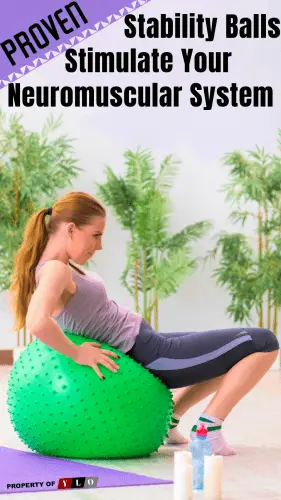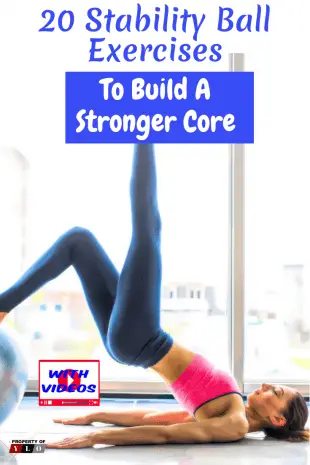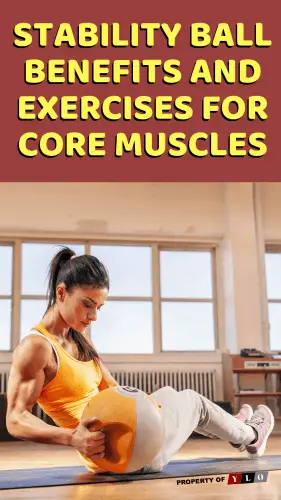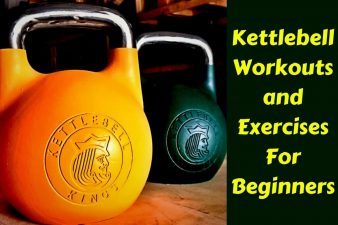Stability Ball benefits should be the center of conversation when someone talks about physical fitness. The stability ball is a versatile piece of equipment that is used by many personal fitness trainers around the world. It is also known as Balance Balls, Physio Balls, and Swiss Balls.
Stability Ball Benefits and Exercises for Core Muscles
Recent studies show that more coaches, physical education teachers, and athletic trainers are now using the stability ball in their training programs. They know that the stability ball excels when it comes to helping people develop a strong balance and core strength. There’s a strong possibility that these balls will continue to become more popular as time progresses.
The stability ball’s popularity has led to the development of new physical fitness programs. These programs are being used to educate people from all walks of life. People are learning that a stability ball has many important applications that should not be ignored. It’s fair to say that the stability ball plays a big role in helping people overcome various physical injuries.
European Schools Use Stability Balls
Let’s use Europe as an example. In Europe, stability balls are used as chairs in schools. School officials discovered that stability balls help students focus on their teachers. They also discovered that this fascinating fitness ball helps students organize their school work, write better, and concentrate on assigned tasks.
Several pilot studies in the United States are now using the stability ball in schools. Within the next few years, there’s a possibility that you may see schools in the states using stability balls in the classroom.

Stability Ball is Versatile
It doesn’t take a brain surgeon to see that the stability ball is one of the most versatile pieces of equipment around today. Fun and extremely easy to use. It’s also important to note that it’s also inexpensive and productive.
Researchers have discovered that the stability ball stimulates the neuromuscular system. It’s extremely difficult to find another piece of fitness equipment that does this. Let’s look at several neuromuscular system responses to the stability ball.
- The body’s natural processes
- Neurologically induced muscular responses
- Multiple muscle systems
- The body’s automatic natural processes
- Establishing, restoring, and maintain proper balance
Stability Balls in Sports Training
Experienced therapists with an athletic background found out that the stability ball can help athletes get into better shape, and it can also help them do better in their respective sport. It’s not unusual to see stability balls in strength facilities. Many popular professional athletes have stated that the stability ball has raised their athletic talent.
Let’s look at amateur and professional boxing. The stability ball has helped many amateur and professional boxers hone their skills for the ring. This is the primary reason why you see many boxing trainers have their fighters use the stability ball during training camps.
Stability Ball Popularity Grows
As the stability ball became popular, it found its way into major physical fitness conferences. Exercise professionals held demonstrations and educational clinics.
Personal trainers attending these conferences began to see how the stability ball could help their clients. At the end of the day, you have to credit these personal trainers for bringing the stability ball into commercial training facilities. It’s not odd to see at least one stability ball at a commercial fitness facility.
The stability ball has been a huge hit at commercial fitness centers. One could argue that’s the main reason why it is now being used in the private sector.
At first, the ball was used for rehabilitation. Now it is now being used as a chair in schools and in business offices. We cannot overlook the fact that it is also being used for flexibility training and strength training.

Stability Ball Benefits Proven by Fitness Experts
Stability ball benefits have been established by leading medical researchers and physical fitness experts. One could say that the practice and science behind this phenomenal ball go beyond anecdotal observations.
Stability exercise balls have become extremely popular within the clinical rehabilitation industry. Due to their versatility, they have also become popular outside rehab settings. As we stated earlier, these balls help people develop their balance and core strength.
Stability ball benefits have helped it earn an important spot in functional conditioning and athletic training. Many strength and conditioning experts around the globe have created their own stability ball exercise program. In short, your imagination is the only thing that limits your use for the stability ball.
Choosing a Stability Ball
Choosing a stability exercise ball is not as difficult as you may believe. You should get a ball that will allow you to sit on it with your knees and hips at 90 degrees. Using balls of different sizes will give you more flexibility and options with your training.
General Recommendations
Here are several recommendations that can enhance your safety and fun while working out with the stability ball.
Exercise with a shirt –
You should wear a shirt at all times. Bodies covered in perspiration will more than likely slide off the ball. This can cause a serious injury, especially if you are working out with free weights.
Don’t use limb anchors –
It would be a huge mistake for you to use any form of support for your limbs while training with the stability exercise ball. Limb supports or anchors will disrupt your neuromuscular environment.
Lighter loads for a standard bench –
You should use lighter loads while using external resistance on a standard bench. It’s extremely dangerous for you to use high loads with this form of training. You could injure yourself.
Using spotters –
Using spotters for external resistance equipment is a bright idea. However, you only need minimal supervision if you are using a light load.
Body Alignment
The neutral alignment of your spine is essential when it comes to exercising with a stability ball. If neutral alignment is not present, it will be hard for you to get the stability ball benefits.
Here are a few things you should keep in mind when it comes to neutral alignment
Head (ball under your hips) –
Your neck should not be hyper-flexed. Keep it in a neutral position. I cannot stress how important it is for you to avoid hyperextending your neck while working out.
Core (ball under your hips with your knees and feet in progression) –
Your body will be suspended in a prone position while working out with a stability ball. Make sure that your core is capable of maintaining a posterior pelvic tilt. This will protect your spine from hyperextension. However, you need exceptional abdominal and hip flexor strength to do this.

Stability Ball Benefits
The body’s natural motor reflexes are stimulated if you maintain proper alignment while working out with the stability ball. Your body will be encouraged to respond as one unit.
Training on a stability ball will challenge your entire body to maintain proper posture and balance. This special type of training will also challenge your body to perform dynamic exercise movements.
The stability ball can increase endurance and muscle strength in all your major muscle groups. This dynamic ball can also do following things help you lose extra pounds, improve your posture, improve your balance, improve your flexibility, enhance your spinal stability, restore your flexibility, and compliment your aerobic training program.
I must add that the stability ball is great for stretching. Without the aid of the ball, you may find it difficult to get into certain stretching positions.
Versatility
Here are several stability ball benefits that you can look forward to getting
- It’s reasonably priced.
- Easy to transport on long trips, and it is also easy to store.
- The ball can be used anywhere. You can use it at your residence, in a group setting, and in a personal training setting.
- It’s ideal for people of all ages and walks of life.
- Maintenance free for a long period of time.
Balance is Key
Balance is the key to having success with the stability ball. The ball will help you develop good balance, and it will also challenge muscles throughout your entire body.
Trying to maintain your balance on mobile and moving surfaces is fun and invigorating. You will gradually notice an improvement in your flexibility, strength, and balance. Stability ball benefits can turn your life around!
Stability Balls Started in ReHab
At first, the stability ball was created for rehabilitation purposes. It is now being used for many different training purposes.
Good core strength, spinal stabilization, and endurance are just three stability ball benefits that you can look forward to getting when you work out with this incredible exercise ball.
It’s vital that you adopt a physical fitness program that will challenge your entire body. There are many different types of exercise equipment being sold in the market today.
However, many of them cannot compare to the stability ball. The stability ball is reasonably priced, and it can be used anywhere. You cannot say the same thing for other physical fitness equipment being marketed to consumers.
If you’re looking for a challenge, you should seriously consider getting a stability ball. It is ideal for your mental and physical health.
Stability Ball Exercises
Lower Body
1. Overhead Ball Squat
1. Take the Swiss ball and hold it over your head with your arms locked.
2. Place your feet about shoulder width apart and drop down into a squat.
3. Drop down to about a 90-degree angle and then stand back up.
2. Wall Squat
1. Place the ball between the wall and your lower back, walking your feet out slightly.
2. Lower your body toward the floor in a squat position as you continuously push back into the ball.
3. Bend your knees to 90 degrees or as far as feels comfortable to you.
4. Straighten your legs, keeping your weight over your heels to return to standing position.
3. Standing Ball Squeeze
1. Keeping your weight in the heel of your front foot, bend your knees to lower your body toward the floor. Allow the ball to roll onto your back shin
2. Pause, then push through your front heel to stand up, rolling the top of your foot back onto the ball
4. Hamstring Curl
1. Assume start position as shown by lying on the floor, back of calves resting against the ball.
2. Lift butt off the floor by lifting hips toward the ceiling.
3. Pull the ball in with your feet.
4. Push the ball back out.
5. Squat and Reach
1. Take a stability ball and place it against the wall. Position yourself against it so that the ball is contoured to the arch of your back.
2. Place your feet at shoulder-width with your toes pointed slightly out. Brace your core and keep your chest up.
3. Bend first at the knees and then at the hips. Lower yourself until your thighs are parallel with the floor. Allow the stability ball to guide you but do not put all of your weight against it. Return to the starting position.
6. Ball Lunge with Weights
1. Place the stability ball between the small of your back and a wall. Put one foot behind you against the wall and the other in front of your body. Be sure that your knee does not extend past the foot.
2. Keeping your back straight, lower your body until your front knee is bent at a 90-degree angle.
3. Lift the body back up to the starting position using the quadriceps muscles. Repeat the action.
7. Reverse Extension
1. Starting Position: Lie prone (on your stomach) over the top of a properly-inflated stability ball (one that compresses approximately 6″ under your body weight) with both feet and hands on the floor, hip- and shoulder-width apart.
Upward Phase:
2. Gently exhale, contract your abdominal/core muscles to stiffen your torso and slowly walk yourself forward until your hips lie directly over the top of the ball, lifting both legs in unison off the floor until they are parallel with your torso. In this position, your body weight is distributed over the ball and supported by both hands placed on the floor. Press and hold your legs together so they move at the same time. Think about squeezing a quarter between your knees to help maintain the position.
Lowering Phase:
3. Inhale and slowly lower both legs in unison back towards the floor while keeping them fully extended.
Stability Ball Exercises for the Upper Body
8. Balance Push-Up
1. Lay with your chest on the stability ball.
2. Place your hands on the ball at the sides of your chest.
3. Place your toes on the floor, legs straight.
4. Push your body up until your arms are almost straight (do not lock your elbows)
9. Standing Plank
1. To perform the plank on the ball in standing, stand in front of the ball and place your hands on the ball about shoulder-width apart.
2. Legs should be straight and feet shoulder width apart.
3. You should form a straight line from your head to your feet.
4. Keep your abdominals engaged and back and neck in a neutral position.
10. Roll Out
1. Kneel on the ground and place a Swiss Ball in front of you. Cross your feet in the back. …
2. Begin the movement by slowly rolling out with the Swiss Ball. Feel the contraction of your core as you move further out.
3. Once you are fully extended, pause, then slowly roll back up to the starting position.
11. Back Extension
1. Start by placing your body on top of the stability ball and planting your feet against the wall a bit wider than shoulder width.
2. Place your hands to the side of your head and slowly lower your body down on to the stability ball.
3. Lower your body back down to the starting position using complete control through the whole range of motion.
12. Tricep Dips
1. Place your hands on the bench beside you and put your feet up on the stability ball.
2. Keeping your back straight and your tailbone close to the bench, lower your body down until your elbows have reached 90 degrees.
3. Raise your body, fully extending your arms and contracting your tricep muscles. Repeat action.
13. Pike
Starting Position:
1. Lie prone (on your stomach) over the top of a properly-inflated stability ball (one that compresses approximately 6″ under your body weight) with both feet and hands on the floor, hip- and shoulder-width apart.
2. Gently exhale, contract your abdominal/core muscles to stiffen your torso and slowly walk yourself forward, lifting your legs off the floor. Continue walking out until your toes, with ankles in dorsiflexion (toes pointed towards your shins), rest on the top of the ball. Maintain a rigid torso aligned parallel with your legs
Curling Phase:
3. Exhale and while keeping your legs fully extended, pull your feet towards your chest, rolling the ball forward as your hips move upwards (think about lifting your rear end towards the ceiling while hinging at the hips).
Lowering Phase:
4. Inhale and slowly lower yourself back towards the floor, returning your body to the starting position.
Stability Ball Exercises for Your Core
14. V-Sit With Ball
1. Begin in a seated position with hands and feet on the floor.
2. Slowly contract your abdominal muscles and core and lift your legs up to a 45-degree angle.
3. Reach your arms straight forward or reach up toward your shins as you are able.
4. It’s important to maintain good core posture and a strong spine throughout the movement and to avoid rounding the shoulders forward.
5. Hold this V-shaped position for several seconds to begin.
15. Ball Jog
1. Jog In Place with the ball held in front of you
2. Move the ball overhead
3. Move the ball as low as possible while standing straight.
4. Return to the starting point
16. Hand Off
1. Lay face up on the ground with back flat.
2. Raise legs off the ground and hold in the air. Hold the ball in your hands over the head.
3. Raise the ball up to the legs, placing the ball between the legs.
4. Lower legs to the floor.
17. Knee Tucks
1. Position yourself on all fours with your torso on a swiss ball and hands and feet on the floor. Stretch your legs back and keep your hands under your shoulders.
2. Engage your abs and slowly walk your hands forward until your feet lift off the floor.
3. Carry on walking out until your quads or knees rest on the ball in a plank position.
4. Slowly bend your knees in towards your chest allowing the ball to roll forward. Tuck your knees under your torso as your hips lift towards the ceiling.
5. Slowly straighten your legs and roll the ball out to the starting position.
18. Knee Raise
1. Sit in a seated position and place a stability ball between your legs.
2. Straighten your legs and then bring your knees to your chest and lift the ball off the floor.
19. Ski Step
1. Lie faceup on the ball, draping the entire back of your body over it, arms extended overhead with palms up, fingertips on the floor.
2. Keeping knees bent and pointing straight up, walk your feet out.
20. Side Squat
1. Stand with your exercise ball to your side.
2. Place the inside of your foot on the ball.
3. Lift your arms so that your shoulders are at 90 degrees.
4. Engage your abdominal muscles through the abdominal hollowing exercise.
5. Lower yourself down as far as you can go while still maintaining control.
6. Slowly rise back up.
A helpful article by WebMD: Having a ‘Ball’ With Exercise



